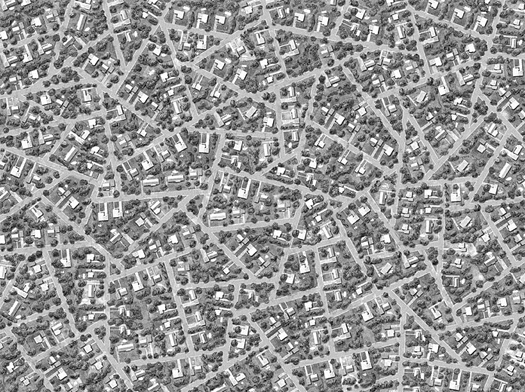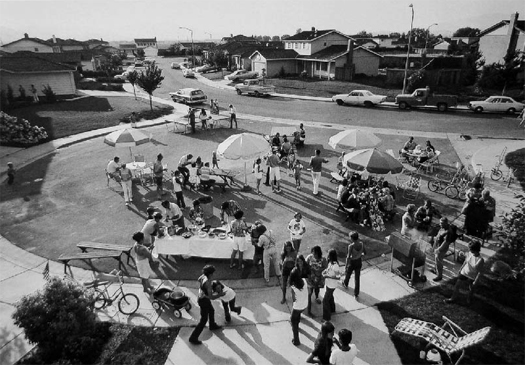
[“Subdivision: Sunshine Acres”, by Ross Racine.]
Thomas Sugrue, in a Wall Street Journal article on the American culture of home ownership from August:
Every generation has offered its own version of the claim that owner-occupied homes are the nation’s saving grace. During the Cold War, home ownership was moral armor, protecting America from dangerous outside influences. “No man who owns his own house and lot can be a Communist,” proclaimed builder William Levitt. With no more reds hiding under the beds, Bill Clinton launched National Homeownership Day in 1995, offering a new rationale about personal responsibility. “You want to reinforce family values in America, encourage two-parent households, get people to stay home?” he said. George W. Bush similarly pledged his commitment to “an ownership society in this country, where more Americans than ever will be able to open up their door where they live and say, ‘welcome to my house, welcome to my piece of property'”…
Some countries—such as Spain and Italy—have higher rates of home ownership than the U.S., but there, homes are often purchased with the support of extended families and are places to settle for the long term, not to flip to eager buyers or trade up for a McMansion. In France, Germany, and Switzerland, renting is more common than purchasing. There, most people invest their earnings in the stock market or squirrel it away in savings accounts. In those countries, whether you are a renter or an owner, houses have use value, not exchange value.
I tend to focus on technological (automobile), infrastructural (the interstate system, the regulatory dictatorship of the fire engine and its turning radii) and political (tax policies that favor home ownership, strict single-use zoning) reasons for the development of the form and ubiquity of the American suburb, but it is also very interesting to consider the suburb as the outgrowth of a cultural ideal, of a particular understanding of the relationship between person and home, or to consider the financial crisis as the (il)logical conclusion of that ideal, cultivated to absurd proportion and applied without regard to circumstance. That ideal is so deeply embedded in our culture that it is nearly invisible, seeming not a cultural construction but an essential and timeless rule, as deeply-embedded ideals often do.

The remainder of Sugrue’s piece develops a genealogy for this ideal of home ownership, leading to Sugrue’s conclusion, which is that the American ideal of home ownership is ultimately not founded on the rationales of personal responsbility, security, or stablity, but upon the notion of the home as an asset for the cultivation of personal wealth. At Front Porch Repulbic, James Matthew Wilson suggests that the lineage runs deeper than the 20th century political decisions Sugrue identifies, connecting the notion of the home-as-wealth-generator to Tocqueville’s observations:
This is not a new distinction, but it certainly is a vital one. Tocqueville observed in Democracy in America that the American restlessness, the constant pursuit of money because of the insecurity and evanescence of family fortunes in an intensely liquid capitalist, industrial society, saturated Americans’ practices of farming and property ownership. To a lesser extent — rather than a greater — than older and more traditional societies, Americans cherished the stability, autarky, and intergenerational continuity of property ownership. In an age when most agriculture was still subsistence agriculture, Tocqueville saw that Americans had managed to huckster farming into a short-term investment scheme; the American farmer might buy a patch of land, cultivate it for a few years, and, once the rocks had all been removed from the fields and the land turned to good account for a few seasons, that farmer was likely to sell it off and move away.
Architecturally, this is a strange notion — that the primary function of the home is to generate wealth, rather than to provide shelter, but it does, I think, go a long ways towards explaining the dominance of the primary architectural forms of contemporary America (the cheaply built urban condo and the even more cheaply built suburban home). How many school studios studying residential architecture begin by assuming that the primary purpose of the homes they design is to provide shelter and how many assume that it is to generate wealth (or, how many even raise the notion that a function of the home might be to generate wealth)? The obvious challenge for the architect, then, is whether to accept and work within the framework provided by that dominant understanding of the home (suburban Koolhaas), to do work which critiques or rejects the ideal of the home as a wealth-generating mechanism, or to look for a middle way (studying the framework in order to subvert it? homes which make explicit their duty as temporary profit generators by self-destructing after a certain period of time?).
[not unrelated: I won’t pretend that I know which (if any) of those options is best, but I will say that Stephen and I have been trying to develop a consistent argument that it is best to do architecture (even paper architecture) in a way that, at the very least, acknowledges the presence of the underlying motivations of the people we design for, even if it questions or subverts those motivations; links to the articles above via The League of Ordinary Gentlemen]


[…] and previously on mammoth: The house is not a machine for living, but for making money; also, if you did begin the hack the […]
[…] in other words, have exploited the values and aims of ownership culture (which mammoth has suggested understands the house to be first a machine for making money and only […]
[…] in other words, have exploited the values and aims of ownership culture (which mammoth has suggested understands the house to be first a machine for making money and only […]
[…] in other words, have exploited the values and aims of ownership culture (whichmammoth has suggested understands the house to be first a machine for making money and only […]
[…] expands on what this means: Elemental, in other words, have exploited the values and aims of ownership culture (which mammoth has suggested understands the house to be first a machine for making money and only […]
[…] the connection between Sugrue’s thesis and suburban architecture in a blog post entitled ownership culture. 2 Net Revenue and viewership figures cited here are from Scripps Networks Interactive, Inc […]